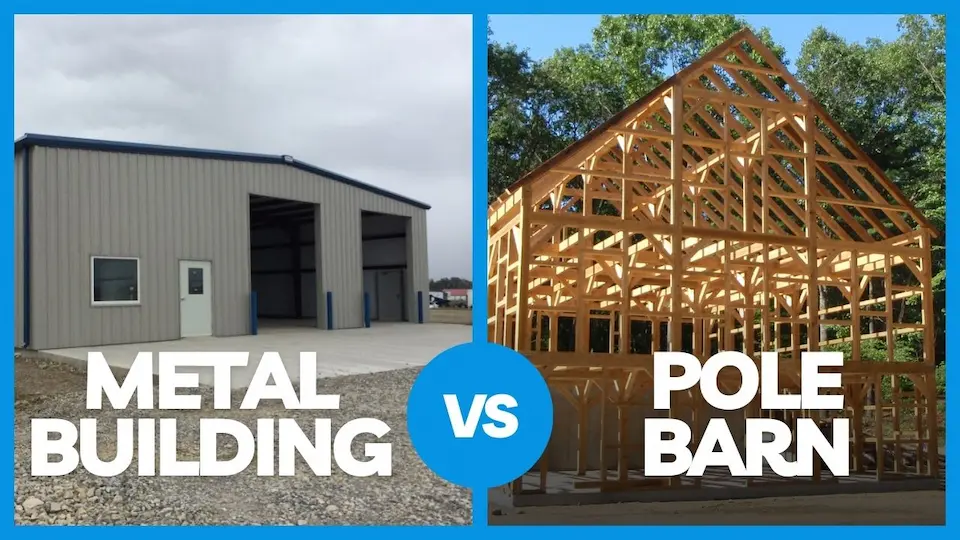Pole Barn vs Steel Building

Pole Barn vs Steel Building – Which One is Right for You?
When considering a new structure for your property, the decision between a pole barn and a steel building can be challenging.
Both types of structures offer distinct advantages depending on your needs, budget, and location.
Here's a detailed comparison to help you decide which option is the best fit for your home or business.
What Is a Pole Barn?
A pole barn is a building supported by large poles or posts embedded in the ground.
These poles are typically made of wood, although they can also be made of metal or concrete.
Pole barns are commonly used for agricultural purposes, such as storing farm equipment, hay, and livestock. However, they can also serve residential or commercial needs.
Advantages of Pole Barns:
Cost-Effective: Pole barns are generally cheaper to construct than other types of buildings due to fewer materials and simpler construction methods.
Quick Construction: The design of pole barns allows for faster construction compared to traditional buildings.
Versatile: Ideal for agricultural, storage, and workshop uses, pole barns can be adapted to various needs.
Customizable: Easily modified to fit your specific requirements, including expansions or upgrades.
Energy-Efficient: With proper insulation, pole barns can help reduce energy costs, making them energy-efficient.
Disadvantages of Pole Barns:
Limited Design Options: Pole barns have a simpler design, which may not appeal to those looking for more aesthetically sophisticated structures.
Maintenance Issues: Wood, in particular, can be prone to rot, pests, and weather-related damage, requiring more maintenance over time.
Vulnerable to Weather: Wooden pole barns may struggle in areas prone to high winds or heavy snow unless designed to handle these conditions.
Insulation Challenges: Without proper insulation, pole barns can be hard to heat and cool, making them less comfortable for human occupation.
Permitting Restrictions: Some areas have zoning laws or regulations that may restrict the use or construction of pole barns.
Lifespan of a Pole Barn:
A well-constructed pole barn can last several decades, but the longevity of wooden structures depends heavily on the quality of materials, climate, and regular maintenance.
Pre-Fabricated Steel Buildings
Pre-fabricated steel buildings, also called pre-engineered buildings, are structures built using pre-cut, pre-drilled steel components manufactured off-site and assembled on-site.
These buildings are known for their strength and efficiency and are ideal for a variety of purposes, including warehouses, storage facilities, retail spaces, and even homes.
Advantages of Steel Buildings:
Durability: Steel buildings are resistant to weather damage, pests, and rot, making them ideal for harsh conditions or high-wind areas.
Low Maintenance: Steel buildings require minimal upkeep due to their resistance to decay and pests.
Energy-Efficient: Steel buildings can be easily insulated, reducing energy costs for heating and cooling.
Customizable: Steel buildings offer extensive design flexibility, including various roof types, colors, and interior finishes.
Fire-Resistant: Unlike wood, steel is naturally fire-resistant, reducing the risk of fire damage.
Disadvantages of Steel Buildings:
Higher Initial Cost: Steel buildings generally cost more upfront than pole barns due to the cost of materials and specialized labor required for installation.
Noise: Steel can be noisy during rain or hail due to its hard, reflective surface.
Condensation: Without proper insulation and ventilation, steel buildings may experience condensation, which can cause rust, mold, and water damage.
Difficult to Modify: Once a steel building is constructed, modifying it can be more challenging and expensive than modifying a wood structure.
Permit and Zoning Restrictions: Some areas may have stringent requirements for steel building construction that can add time and cost to the process.
Lifespan of a Steel Building:
A well-built steel building can last 50 years or more, significantly outlasting pole barns.
Steel's durability and minimal maintenance needs make it a long-term investment.
Factors to Consider When Deciding Between a Pole Barn and a Steel Building
1. Climate and Weather Conditions:
Pole barns are a good option for mild climates but may not perform well in areas with extreme weather, such as heavy snow, high winds, or hurricanes.
Steel buildings are designed to withstand severe weather conditions, making them a better choice for regions prone to harsh climates.
2. Intended Use:
Pole barns are typically used for agricultural purposes or as storage spaces. They are also great for workshops or garages.
Steel buildings are highly versatile and can be used for industrial, residential, commercial, or agricultural purposes. They offer more customization and flexibility in terms of usage.
3. Size and Customization:
Pole barns tend to be less expensive and provide a lot of open space, which makes them ideal for large storage areas or workshops.
Steel buildings offer more customization in terms of design, insulation, and layout, making them suitable for both residential and commercial properties with specific needs.
4. Long-Term Maintenance and Durability:
Pole barns generally require more maintenance and are susceptible to the natural deterioration of wood, pests, and weather-related damage.
Steel buildings require significantly less maintenance and offer greater durability over time, saving you money and effort on upkeep.
Pole Barn vs Metal Building FAQs
How long does a pole barn last compared to a steel building?
Steel buildings typically last 50+ years, whereas pole barns (especially wood-based) last 20-30 years, depending on maintenance and climate.
Are steel buildings more expensive than pole barns?
Yes, steel buildings generally have a higher upfront cost due to materials and installation complexity. However, they offer long-term durability and energy savings that can offset initial costs.
Which option is better for extreme weather conditions?
Metal buildings are better suited for extreme weather, such as high winds, heavy snow, or hurricanes, due to their durability and resistance to pests and decay.





